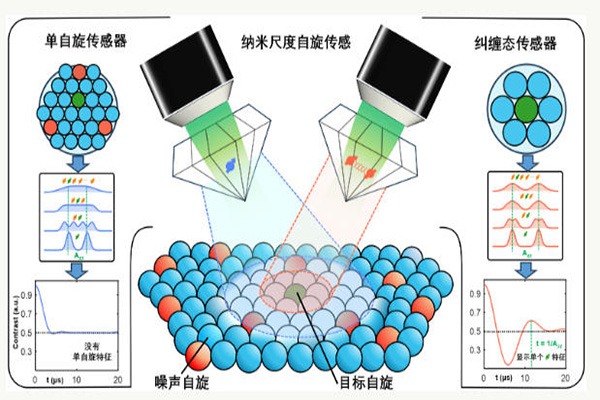Chinese scientists have achieved entanglement-enhanced nanoscale single-spin quantum sensing.

Reporters learned from the University of Science and Technology of China (USTC) that Professor Wang Ya and his team from the university's Spin Magnetic Resonance Laboratory, in collaboration with the National Key Laboratory of Marine Precision Sensing Technology at Zhejiang University, have made significant progress in the field of nanoscale quantum precision measurement, achieving for the first time the detection of a single nanoscale spin enhanced by entanglement under noisy conditions. The relevant research results were published online in the internationally renowned academic journal *Nature* on November 27th (Beijing time).
In the microscopic world, the "spin" of electrons is one of their fundamental properties, acting like tiny magnetic needles. Many macroscopic properties of materials, such as the magnetism of magnets or the zero resistance of superconductors, originate from the arrangement and interaction of these microscopic "magnetic needles."
Researchers explained that detecting a single spin, measuring the most fundamental magnetic unit of the material world, not only provides a new perspective for understanding the properties of matter but also lays a solid foundation for developing single-molecule magnetic detection technology and advancing quantum technology. However, because matter contains a large number of spins, detecting a single spin is akin to clearly catching someone's whisper in a noisy stadium, posing a challenge to related technologies.
Diamond nitrogen-vacancy color center quantum sensors, due to their nanoscale resolution and highly sensitive magnetic detection capabilities, have long been a crucial technological approach for achieving single-spin detection. The research team, through long-term accumulation of expertise, has developed high-precision spin quantum control technology and core devices and equipment for diamond quantum sensing, aiming towards the scientific goal of single-spin detection. In previous work, they were able to identify single spins with special "markers" through spectral differences.
The researchers explained that for over a decade, the team has focused on the independent fabrication of high-quality diamond quantum sensors, establishing a complete process flow encompassing more than twenty steps and mastering the key technologies. Through synergistic innovation along two paths—material preparation and quantum manipulation—they have successfully developed, for the first time, entanglement-enhanced nanoscale single-spin detection technology. This achieves a simultaneous improvement in sensitivity and spatial resolution of microscopic magnetic signals in a solid-state system, paving the way for the continued development of nanoscale quantum precision measurement technology.
This groundbreaking technology has achieved three major advancements: successfully distinguishing and detecting two adjacent "dark" electron spins; increasing detection sensitivity to 3.4 times the level of a single sensor in noisy environments; and enabling real-time monitoring and active modulation of unstable spin signals.
Researchers stated that this achievement not only experimentally verifies the advantages and enormous potential of quantum entanglement in nanoscale sensing but also demonstrates that diamond quantum sensors can serve as powerful nanomagnetometers, opening a new window for the study of quantum materials at the atomic level and providing revolutionary research tools for fields such as condensed matter physics, quantum biology, and chemistry. The controllable preparation and quantum entanglement manipulation techniques of related diamond nitrogen-vacancy color centers are also key foundations for realizing room-temperature diamond quantum computing.









